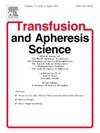血浆产品中线粒体DNA水平:COVID-19恢复期供体采血血浆与未感染供体采血和新鲜冷冻血浆的比较研究
IF 1.2
4区 医学
Q4 HEMATOLOGY
引用次数: 0
摘要
细胞和线粒体应激可以触发线粒体DNA (mtDNA)作为损伤相关分子模式(DAMPs)的细胞外释放,这可能会放大炎症反应并导致输血相关的不良事件。本研究旨在量化血浆产品中的mtDNA水平,评估储存时间和制备方法(单采与FFP)的影响。研究设计与方法横断面分析时间为2022年3月至2023年3月。血浆样本包括通过全血离心获得的16单位新鲜冷冻血浆(FFP)和使用Haemonetics MCS+系统收集的32单位单采血浆。采血者分为新冠肺炎恢复期(n = 16)和未感染组(n = 16)。经RT-PCR证实,恢复期的供体至少在30天内消除了轻度至中度感染。实时荧光定量pcr检测mtDNA。使用GraphPad Prism 8进行数据分析,采用适当的参数和非参数检验。结果非感染供体采血血浆mtDNA平均浓度最高(2.3 × 10⁶copies/mL),其次为恢复期血浆(8.2 × 10⁶copies/mL)和FFP(6.0 × 10⁶copies/mL)。FFP mtDNA水平在储存期间保持稳定,而血浆在30天内显着增加。恢复期血浆mtDNA浓度与抗体滴度呈中度正相关。结论不同血浆制备方法的mtdna浓度不同。这些发现强调了处理变量与输血安全的相关性,并提示mtDNA可以作为产品质量的分子标记。本文章由计算机程序翻译,如有差异,请以英文原文为准。
Mitochondrial DNA levels in plasma products: A comparative study of apheresis plasma from COVID-19 convalescent donors and apheresis and fresh frozen plasma from non-infected donors
Background
Cellular and mitochondrial stress can trigger the extracellular release of mitochondrial DNA (mtDNA) as damage-associated molecular patterns (DAMPs), which may amplify inflammatory responses and contribute to transfusion-related adverse events. This study aimed to quantify mtDNA levels in plasma products, assess the effects of storage duration and preparation method (apheresis vs. FFP).
Study design and methods
A cross-sectional analysis was conducted from March 2022 to March 2023. Plasma samples included 16 units of fresh frozen plasma (FFP) obtained via whole blood centrifugation and 32 units of apheresis plasma collected using the Haemonetics MCS+ system. Apheresis donors were stratified into COVID-19-convalescent (n = 16) and non-infected (n = 16) groups. Convalescent donors had resolved mild-to-moderate infection for at least 30 days, confirmed by RT-PCR. mtDNA quantification was performed using real-time qPCR. Data were analyzed with GraphPad Prism 8 using appropriate parametric and non-parametric tests.
Results
Apheresis plasma from non-infected donors had the highest mean mtDNA concentration (2.3 × 10⁶ copies/mL), followed by convalescent plasma (8.2 × 10⁵ copies/mL) and FFP (6.0 × 10⁵ copies/mL). FFP mtDNA levels remained stable during storage, while apheresis plasma demonstrated a significant increase over 30 days. A moderate positive correlation was observed between mtDNA concentration and antibody titers in convalescent plasma.
Conclusion
mtDNA concentrations vary by plasma preparation method. These findings highlight the relevance of processing variables in transfusion safety and suggest mtDNA may serve as a molecular marker for product quality.
求助全文
通过发布文献求助,成功后即可免费获取论文全文。
去求助
来源期刊
CiteScore
3.60
自引率
5.30%
发文量
181
审稿时长
42 days
期刊介绍:
Transfusion and Apheresis Science brings comprehensive and up-to-date information to physicians and health care professionals involved in the rapidly changing fields of transfusion medicine, hemostasis and apheresis. The journal presents original articles relating to scientific and clinical studies in the areas of immunohematology, transfusion practice, bleeding and thrombotic disorders and both therapeutic and donor apheresis including hematopoietic stem cells. Topics covered include the collection and processing of blood, compatibility testing and guidelines for the use of blood products, as well as screening for and transmission of blood-borne diseases. All areas of apheresis - therapeutic and collection - are also addressed. We would like to specifically encourage allied health professionals in this area to submit manuscripts that relate to improved patient and donor care, technical aspects and educational issues.
Transfusion and Apheresis Science features a "Theme" section which includes, in each issue, a group of papers designed to review a specific topic of current importance in transfusion and hemostasis for the discussion of topical issues specific to apheresis and focuses on the operators'' viewpoint. Another section is "What''s Happening" which provides informal reporting of activities in the field. In addition, brief case reports and Letters to the Editor, as well as reviews of meetings and events of general interest, and a listing of recent patents make the journal a complete source of information for practitioners of transfusion, hemostasis and apheresis science. Immediate dissemination of important information is ensured by the commitment of Transfusion and Apheresis Science to rapid publication of both symposia and submitted papers.

 求助内容:
求助内容: 应助结果提醒方式:
应助结果提醒方式:


